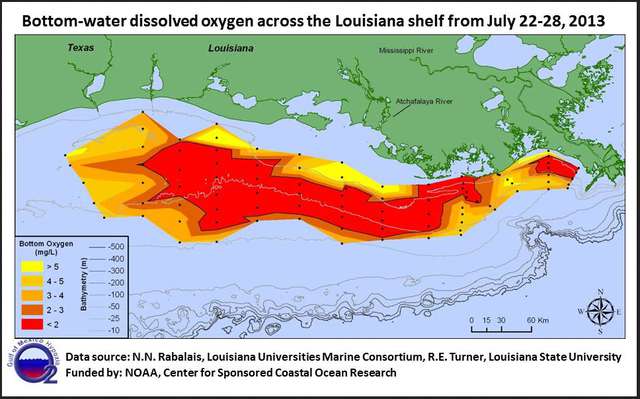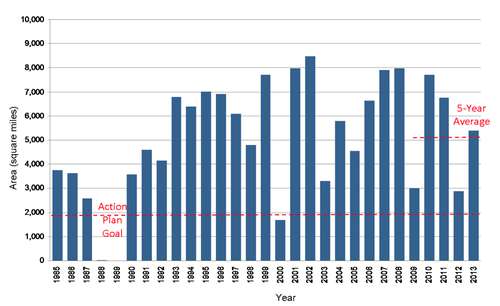New projections for 2013 Gulf of Mexico dead zone

Image: LUMCON (Rabalais)
Every year, excess nitrogen and phosphorous pollution gets dumped into the Mississippi River. These pollutants flow downstream and eventually reach the Gulf of Mexico. Just as nitrogen and phosphorus fertilizers promote crop growth, the excess nutrients feed massive algae blooms in the Gulf.
When these algae die off, their decomposition process robs the water of oxygen, suffocating marine life that is unable to escape. The lack of oxygen threatens aquatic life and endangers the local fishing and tourism industry.
New measurements taken by scientists supported by the National Oceanic and Atmospheric Administration (NOAA) report the 2013 dead zone in the Gulf of Mexico to be 5,840 square miles, more than double the goal set in 2001 by the Gulf of Mexico/Mississippi River Watershed Nutrient Task Force of 1,900 square miles.
This years dead zone, which is roughly the size of the State of Connecticut, is above the long-term average and above the average size of the last five years.

Historical hypoxia trends in the Gulf of Mexico
Image: LUMCON (Rabalais)
The total annual load of excess nitrogen into the Gulf of Mexico now exceeds 1.5 million metric tons. According to scientists, most of this pollution comes from unregulated corn and soybean agriculture in the upper Midwest.
Similarly, nitrate-nitrogen pollution to Minnesotas surface waters in dominated by agriculture, with more than 70% of the states nitrate pollution coming from agriculture, mostly via artificial drain tile systems.
While the dead zone is a complex and dynamic problem, its clear that substantial improvements in agricultural conservation are required to fully address excess nitrogen pollution to the nations surface waters. Traditional voluntary conservation programs (subsidized by the general public) have yielded limited results, even after decades of implementation.
Vast improvements in in-field nutrient management and tile drainage water management, along with changes in cropping systems and widespread landscape diversification, are needed to address nitrate pollution to Minnesotas surface waters and the Gulf of Mexico.
For more info about nitrate pollution to Minnesotas surface waters, visit the MPCAs website.
For more info about Gulf Hypoxia, visit EPA.gov.